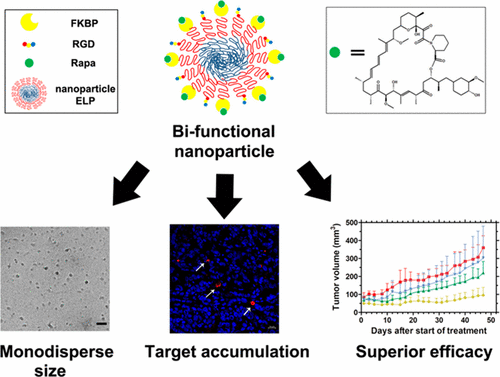当前位置:
X-MOL 学术
›
Bioconjugate Chem.
›
论文详情
Our official English website, www.x-mol.net, welcomes your
feedback! (Note: you will need to create a separate account there.)
Bifunctional Elastin-like Polypeptide Nanoparticles Bind Rapamycin and Integrins and Suppress Tumor Growth in Vivo
Bioconjugate Chemistry ( IF 4.0 ) Pub Date : 2017-10-12 00:00:00 , DOI: 10.1021/acs.bioconjchem.7b00469 Jugal P. Dhandhukia 1 , Pu Shi 1 , Santosh Peddi 1 , Zhe Li 1 , Suhaas Aluri 1 , Yaping Ju 1 , Dab Brill 1 , Wan Wang 1 , Siti M. Janib 1 , Yi-An Lin 2 , Shuanglong Liu , Honggang Cui 2 , J. Andrew MacKay 1, 3
Bioconjugate Chemistry ( IF 4.0 ) Pub Date : 2017-10-12 00:00:00 , DOI: 10.1021/acs.bioconjchem.7b00469 Jugal P. Dhandhukia 1 , Pu Shi 1 , Santosh Peddi 1 , Zhe Li 1 , Suhaas Aluri 1 , Yaping Ju 1 , Dab Brill 1 , Wan Wang 1 , Siti M. Janib 1 , Yi-An Lin 2 , Shuanglong Liu , Honggang Cui 2 , J. Andrew MacKay 1, 3
Affiliation

|
Recombinant protein–polymer scaffolds such as elastin-like polypeptides (ELPs) offer drug-delivery opportunities including biocompatibility, monodispersity, and multifunctionality. We recently reported that the fusion of FK-506 binding protein 12 (FKBP) to an ELP nanoparticle (FSI) increases rapamycin (Rapa) solubility, suppresses tumor growth in breast cancer xenografts, and reduces side effects observed with free-drug controls. This new report significantly advances this carrier strategy by demonstrating the coassembly of two different ELP diblock copolymers containing drug-loading and tumor-targeting domains. A new ELP nanoparticle (ISR) was synthesized that includes the canonical integrin-targeting ligand (Arg-Gly-Asp, RGD). FSI and ISR mixed in a 1:1 molar ratio coassemble into bifunctional nanoparticles containing both the FKBP domain for Rapa loading and the RGD ligand for integrin binding. Coassembled nanoparticles were evaluated for bifunctionality by performing in vitro cell-binding and drug-retention assays and in vivo MDA-MB-468 breast tumor regression and tumor-accumulation studies. The bifunctional nanoparticle demonstrated superior cell target binding and similar drug retention to FSI; however, it enhanced the formulation potency, such that tumor growth was suppressed at a 3-fold lower dose compared to an untargeted FSI–Rapa control. This data suggests that ELP-mediated scaffolds are useful tools for generating multifunctional nanomedicines with potential activity in cancer.
中文翻译:

双功能弹性蛋白样多肽纳米粒子绑定雷帕霉素和整合素和抑制体内肿瘤的生长。
重组蛋白-聚合物支架,例如弹性蛋白样多肽(ELP),提供了药物递送的机会,包括生物相容性,单分散性和多功能性。我们最近报道了FK-506结合蛋白12(FKBP)与ELP纳米颗粒(FSI)的融合增加了雷帕霉素(Rapa)的溶解度,抑制了乳腺癌异种移植物中的肿瘤生长,并减少了用自由药物对照观察到的副作用。这份新的报告通过展示包含载药域和肿瘤靶向域的两种不同的ELP二嵌段共聚物的共组装,大大改善了这种载体策略。合成了一种新的ELP纳米粒子(ISR),其中包括靶向整联蛋白的配体(Arg-Gly-Asp,RGD)。FSI和ISR以1:混合 1摩尔比共组装成双功能纳米粒子,该纳米粒子既包含用于Rapa加载的FKBP域,又包含用于整合素的RGD配体。通过执行体外细胞结合和药物保留测定以及体内MDA-MB-468乳腺肿瘤消退和肿瘤蓄积研究,评估了共组装的纳米颗粒的双功能性。双功能纳米颗粒具有优异的细胞靶结合能力,并且与FSI具有相似的药物保留能力。但是,它增强了制剂的效力,因此与未靶向的FSI-Rapa对照相比,其肿瘤生长受到了低3倍的抑制。该数据表明,ELP介导的支架是用于产生在癌症中具有潜在活性的多功能纳米药物的有用工具。通过执行体外细胞结合和药物保留测定以及体内MDA-MB-468乳腺肿瘤消退和肿瘤蓄积研究,评估了共装配的纳米颗粒的双功能性。双功能纳米颗粒具有优异的细胞靶结合能力,并且与FSI具有相似的药物保留能力。但是,它增强了制剂的效力,因此与未靶向的FSI-Rapa对照相比,其肿瘤生长受到了低3倍的抑制。该数据表明,ELP介导的支架是用于产生在癌症中具有潜在活性的多功能纳米药物的有用工具。通过执行体外细胞结合和药物保留测定以及体内MDA-MB-468乳腺肿瘤消退和肿瘤蓄积研究,评估了共组装的纳米颗粒的双功能性。双功能纳米颗粒具有优异的细胞靶结合能力,并且与FSI具有相似的药物保留能力。但是,它增强了制剂的效力,因此与未靶向的FSI-Rapa对照相比,其肿瘤生长受到了低3倍的抑制。该数据表明,ELP介导的支架是用于产生在癌症中具有潜在活性的多功能纳米药物的有用工具。但是,它增强了制剂的效力,因此与未靶向的FSI-Rapa对照相比,其肿瘤生长受到了低3倍的抑制。该数据表明,ELP介导的支架是用于产生在癌症中具有潜在活性的多功能纳米药物的有用工具。但是,它增强了制剂的效力,因此与未靶向的FSI-Rapa对照相比,其肿瘤生长受到了低3倍的抑制。该数据表明,ELP介导的支架是用于产生在癌症中具有潜在活性的多功能纳米药物的有用工具。
更新日期:2017-10-12
中文翻译:

双功能弹性蛋白样多肽纳米粒子绑定雷帕霉素和整合素和抑制体内肿瘤的生长。
重组蛋白-聚合物支架,例如弹性蛋白样多肽(ELP),提供了药物递送的机会,包括生物相容性,单分散性和多功能性。我们最近报道了FK-506结合蛋白12(FKBP)与ELP纳米颗粒(FSI)的融合增加了雷帕霉素(Rapa)的溶解度,抑制了乳腺癌异种移植物中的肿瘤生长,并减少了用自由药物对照观察到的副作用。这份新的报告通过展示包含载药域和肿瘤靶向域的两种不同的ELP二嵌段共聚物的共组装,大大改善了这种载体策略。合成了一种新的ELP纳米粒子(ISR),其中包括靶向整联蛋白的配体(Arg-Gly-Asp,RGD)。FSI和ISR以1:混合 1摩尔比共组装成双功能纳米粒子,该纳米粒子既包含用于Rapa加载的FKBP域,又包含用于整合素的RGD配体。通过执行体外细胞结合和药物保留测定以及体内MDA-MB-468乳腺肿瘤消退和肿瘤蓄积研究,评估了共组装的纳米颗粒的双功能性。双功能纳米颗粒具有优异的细胞靶结合能力,并且与FSI具有相似的药物保留能力。但是,它增强了制剂的效力,因此与未靶向的FSI-Rapa对照相比,其肿瘤生长受到了低3倍的抑制。该数据表明,ELP介导的支架是用于产生在癌症中具有潜在活性的多功能纳米药物的有用工具。通过执行体外细胞结合和药物保留测定以及体内MDA-MB-468乳腺肿瘤消退和肿瘤蓄积研究,评估了共装配的纳米颗粒的双功能性。双功能纳米颗粒具有优异的细胞靶结合能力,并且与FSI具有相似的药物保留能力。但是,它增强了制剂的效力,因此与未靶向的FSI-Rapa对照相比,其肿瘤生长受到了低3倍的抑制。该数据表明,ELP介导的支架是用于产生在癌症中具有潜在活性的多功能纳米药物的有用工具。通过执行体外细胞结合和药物保留测定以及体内MDA-MB-468乳腺肿瘤消退和肿瘤蓄积研究,评估了共组装的纳米颗粒的双功能性。双功能纳米颗粒具有优异的细胞靶结合能力,并且与FSI具有相似的药物保留能力。但是,它增强了制剂的效力,因此与未靶向的FSI-Rapa对照相比,其肿瘤生长受到了低3倍的抑制。该数据表明,ELP介导的支架是用于产生在癌症中具有潜在活性的多功能纳米药物的有用工具。但是,它增强了制剂的效力,因此与未靶向的FSI-Rapa对照相比,其肿瘤生长受到了低3倍的抑制。该数据表明,ELP介导的支架是用于产生在癌症中具有潜在活性的多功能纳米药物的有用工具。但是,它增强了制剂的效力,因此与未靶向的FSI-Rapa对照相比,其肿瘤生长受到了低3倍的抑制。该数据表明,ELP介导的支架是用于产生在癌症中具有潜在活性的多功能纳米药物的有用工具。


















































 京公网安备 11010802027423号
京公网安备 11010802027423号